Ten Vietnamese Cuisine, Specialties Set New Asian Records
Nominated by the Vietnam Records Organisation (VietKings), these freshly accredited records include the Sai Gon bread from Ho Chi Minh City, mussel rice from Thua Thien-Hue province, Phan Thiet hotpot from Binh Thuan province, vermicelli soup with special broth from Soc Trang province, green sticky rice from Vong village in Hanoi, sesame candy from Thua Thien-Hue, and Da Lat strawberries from Lam Dong province.
Their recognition conforms with the Asian culinary and specialty record criteria.
VietKings has taken a journey to seek and promote the unique value of Vietnam, especially its culinary delights and specialties, since 2010. Each of the 63 cities and provinces nationwide has its distinctive flavors, ingredients, and ways of using and combining spices.
Saigon bread
"Banh mi", a beloved name that has been deeply ingrained in the minds of many Vietnamese people, has become a source of national pride and is considered one of the finest examples of Vietnamese cuisine. Despite facing many challenges throughout its history, Banh mi has successfully crossed national borders and left its mark on the world's culinary scene.
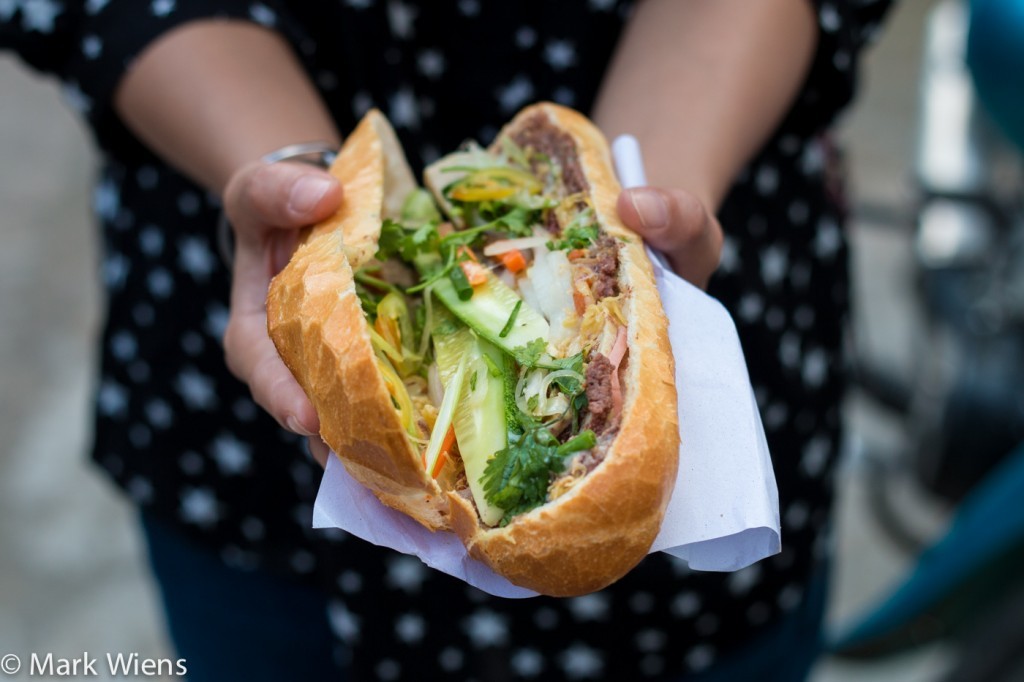 |
| Depending on the ingredients sandwiched inside, banh mi can be divided into different types of Banh mi with different names. Photoo: Mark Weins |
The contents of a Vietnamese baguette, or banh mi, can vary by region and are typically categorized into three main groups: animal ingredients, vegetables, and sauces/condiments. Animal ingredients include roast pork, stewed minced meat with spices, shumai, pate de foie gras, sausage, Vietnamese sausage, chicken, sardines, cheese, fried eggs, spring rolls, cold cuts, tamarind, butter, onion fat, and more. Vegetables typically consist of thinly sliced cucumber, coriander (cilantro), pickles, onions, basil, and more. Sauces and condiments may include soy sauce, fish sauce, pepper sauce, soup powder, chili sauce, and others.
Depending on the ingredients sandwiched inside, banh mi can be divided into different types of Banh mi with different names.
Meatloaf is the most popular type of Banh mi in Vietnam and typically includes cold meat accompanied by rolls, grilled meat sandwiches, or roasted pork sandwiches.
Banh mi shumai is available in many places, but shumai Banh mi in Da Lat is particularly unique and is served in a small bowl filled with soup, shumai balls, pork rolls, pork skin, and scallions.
Mussel rice
Vietnamese prefer hot rice in almost every dish except for mussel rice. Only cold rice is used in mussel rice.
Cold rice and little mussels attract the cook. It is said that the tastiest kind of mussel rice can only be found in Hen Islet. Mussel is the main ingredient in many dishes, such as mussel rice, stir fry mussel and vermicelli, dried young bamboo bud, and sliced pork. The third important ingredient in mussel rice is raw vegetables. Raw vegetables served with mussel rice include many rustic materials such as banana flowers, laksa leaves, star fruit, etc.
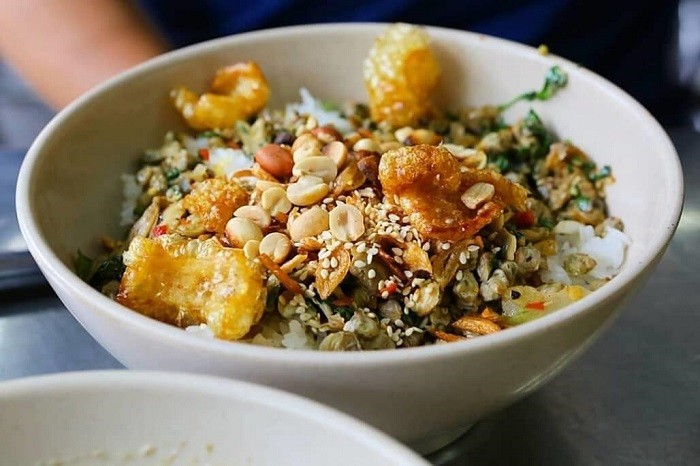 |
| Vietnamese prefer hot rice in almost every dish except for mussel rice. Only cold rice is used in mussel rice. Photo: Danang Private Car |
At last, the hot mussel broth is added to the dish. The ginger-flavored soup makes the bowl of mussel rice complete. There are up to 10 ingredients that can be named in mussel rice such as chili, rice paper, roasted salt, roasted peanut, roasted sesame, dried pig skin, etc. What remains in dinners after eating a bowl of mussel rice is the fragrance of shrimp paste and spiciness. Mussel rice lovers may ask for fresh chili to enjoy the flavor to the fullest.
Green sticky rice – Vong village
Green sticky rice, a traditional Vietnamese dish, is made from young glutinous rice. With its vibrant green color and enticing aroma, this dish is a must-try for any food enthusiast traveling to the S-shaped country.
Vong Village, located in Hanoi, Vietnam, is famous for its culinary specialty, com. This village is also the delicious dish’s place of origin, where it was created during a time of hardship.
Legend has it that during heavy rain and wind, the rice fields were submerged in water. The villagers had to cut the young rice grains, then dry, roast, and eat them to fight hunger. This reluctant product has now become a delicacy with unique flavor and appeal.
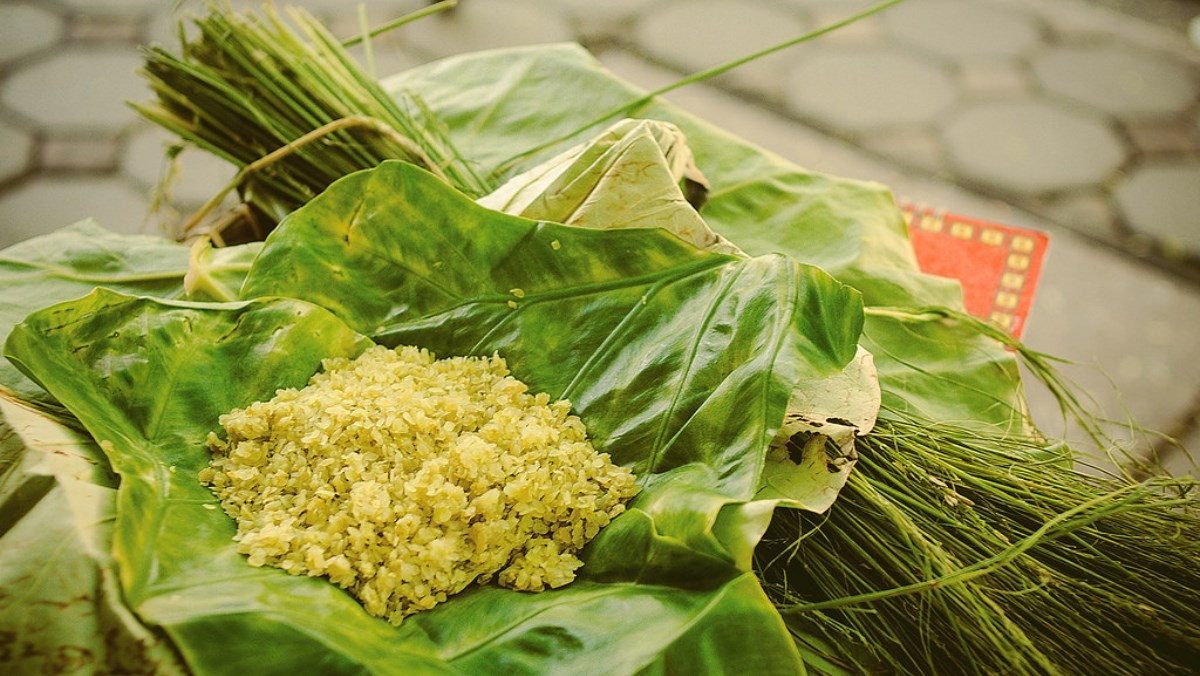 |
| Green sticky rice is a delicacy made from young glutinous rice, usually harvested in the late summer and early autumn months. Photo: Dien may XANH |
The villagers' experience and creativity with young rice buds have created greener, thinner, and more fragrant nuggets, now known as green sticky rice (com).
Green sticky rice is a delicacy made from young glutinous rice, usually harvested in the late summer and early autumn months. Vong Village in Hanoi is known for its traditional method of making com.
Vietnamese rice must be harvested at the right time and carefully selected, sifted, and washed to create the perfect nuggets. The whole process is repeated seven times to ensure that all husks are removed, resulting in flat, young, green, and fragrant rice grains.
This delicacy is wrapped in old lotus leaves. Visitors can immerse themselves in the experience by visiting Vong Village during the nugget-making season, where they can hear the rhythmic sound of wooden pestles pounding into mortars and see the locals sift the young rice.
 | Vietnamese Cuisine Attractive at WIC Charity Fair in Indonesia Traditional products and Vietnamese cuisine received special attention from diners at the 54th Charity Fair of the Women's International Club (WIC) Jakarta. |
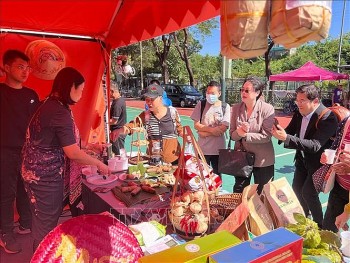 | Vietnamese Dishes, Products Introduced at Hong Kong Food Fiesta Traditional Vietnamese dishes at the 4th Hong Kong Food Fiesta have received an enthusiastic welcome from residents as well as international friends, such as fried ... |
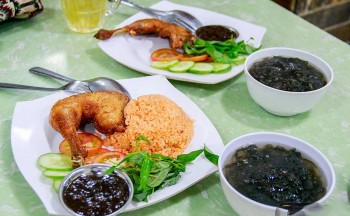 | Foreign Foodie Praises Vietnamese-Styled Deep Fried Chicken A foreign travel blogger has praised the deliciousness of Vietnamese-styled deep-fried chicken and the special technique used to make the dish. |
Recommended
 Handbook
Handbook
Vietnam Moves Up 8 Places In World Happiness Index
 Handbook
Handbook
Travelling Vietnam Through French Artist's Children Book
 Multimedia
Multimedia
Vietnamese Turmeric Fish among Best Asian Dishes: TasteAtlas
 Handbook
Handbook
From Lost to Found: German Tourist Thanks Vietnamese Police for Returning His Bag
Popular article
 Handbook
Handbook
Prediction and Resolution for the Disasters of Humanity
 Handbook
Handbook
16 French Films To Be Shown For Free During Tet Holiday In Vietnam
 Handbook
Handbook
Unique Cultural and Religious Activities to Welcome Year of the Snake
 Handbook
Handbook







